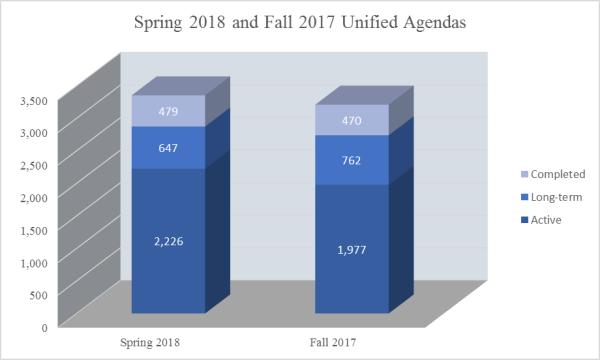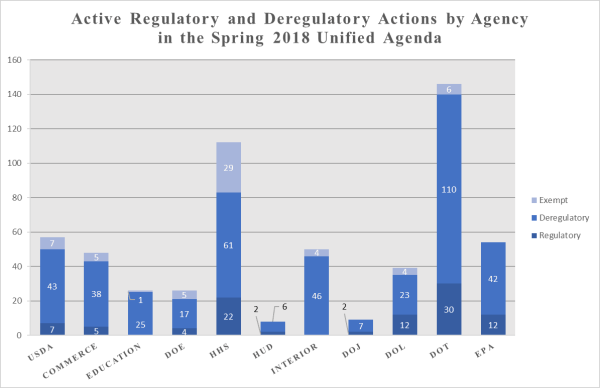Introduction
On Wednesday, the Office of Information and Regulatory Affairs (OIRA) released its semiannual Unified Agenda of Regulatory and Deregulatory Actions. The Agenda provides summaries of the actions underway at regulatory agencies. The current edition identifies whether planned agency actions are regulatory or deregulatory, allowing the public to track the status of regulatory reform efforts by the Trump administration to reduce regulatory burdens.
OIRA administrator Naomi Rao has stated that her goal is to focus on eliminating regulations that limit competition or create unnecessary burdens on the regulated public. The preamble to the Agenda emphasizes “proposed actions that streamline infrastructure development, promote emerging technologies, and provide relief for small businesses.” These include agency actions to withdraw some proposed rules and discontinue activity on others. This Spring Agenda is an indication that agencies are taking seriously their mandate to deregulate as directed under Executive Order 13771, which instructed agencies to remove two significant rules for every additional one they issued and offset the additional cost imposed by any new regulations by reducing costs elsewhere.
What’s in the Spring 2018 Agenda?
The Spring 2018 Unified Agenda includes a total of 3,352 regulatory actions, 234 of which are classified as regulatory, 611 as deregulatory, with the remainder exempt or classified as “other.” Of the total number of actions, 139 are economically significant.1
The Agenda distinguishes between active regulations (those with milestones within the next 12 months), long-term actions, and completed actions. Of the 2,226 actions listed as active approximately 24% are published for the first time in this Spring Agenda.
Table 1: Contents of the Spring 2018 Unified Agenda
Compared to the Fall 2017 Agenda, the total number of actions increased from 3,209 to 3,352. There are also more active rulemakings in this Agenda (2,226 compared to 1,997 last fall). Of those, the number of economically significant actions increased slightly from 71 in the Fall 2017 Agenda to 88 in the Spring 2018 Agenda.
Continued Deregulation
Altogether, for active actions in the Agenda, executive agencies under the Trump administration plan to take an average of approximately 4 deregulatory actions for every 1 regulatory action. Two agencies, the Department of Education (ED) and the Department of the Interior (DOI), each have zero regulatory active actions planned with 25 and 46 deregulatory actions—respectively. The agencies with the most deregulatory actions planned are the Department of Transportation (DOT) with 110 actions and the Department of Health and Human Services (HHS) with 61; these were the same two agencies leading in terms of number of deregulatory actions in the Fall 2017 Agenda.
1According to Executive Order 12866, an “economically significant” regulatory action is one which has “an annual effect on the economy of $100 million or more or adversely affect in a material way the economy, a sector of the economy, productivity, competition, jobs, the environment, public health or safety, or State, local, or tribal governments or communities.”




